Ultimate Earth is a new membership platform for backpackers and their more monied counterparts, “flashpackers”. It’s designed to help them discover discounts and deals with travel providers across the globe, as well as trip planning ideas and advice. Ahead of its official launch early next year, director Dan Apperley speaks exclusively to Globetrender about his inspiration, the problems he’s looking to solve and why losing your luggage can make you have a better time.
What is Ultimate Earth?
Ultimate Earth is the ultimate backpackers’ discount travel club – that’s our tag line. We help them get more out of their adventures by helping them save money on accommodation and adventure activities. We also help backpackers with their planning by providing to-the-point destination guides and articles that cover topics such as budgeting, packing advice and managing your money on the road.
How is it innovative?
We have a lot of innovative features to roll out on the app (more about that another time), but for now I’d say the business model itself is innovative. It’s a different model within the travel industry – instead of setting up with a transactional model, earning a percentage on referrals or sales, we encourage direct bookings.
When speaking with many hostel owners around the world, there is a general feeling that the OTAs (online travel agencies) have some businesses a little over the barrel. Indeed, I quite often hear that about 70 per cent of customers come via the OTAs. As with any business, when so much business is coming from so few places, it represents a risk.
I think Ultimate Earth’s emphasis on direct partner-customer relationships slots in nicely with a wider objective within the industry to drive direct bookings. Because so much business is coming through these transactional booking channels, a lot of organisations we approach to partner with are used to “paying” for their customers via booking fees and commissions.
Because of this, although a direct discount to Ultimate Earth backpackers exists, in reality this has little to no effect on the margins they are used to operating with and, in this sense, everybody wins.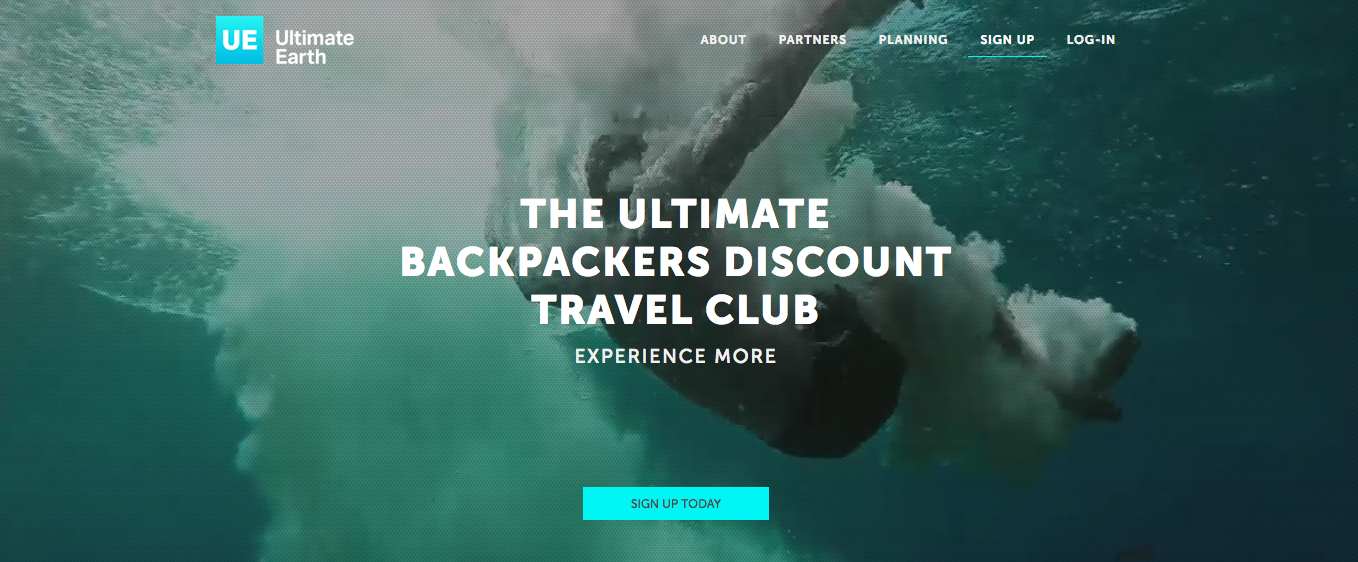
What problem have you set out to solve?
Planning a backpacking adventure can be a daunting prospect. It can also be difficult to know which companies to engage with when you’re actually there. Not only do we help with both of these issues, we help backpackers save money by engaging with the partners within our network – in this sense, I guess you could say we help solve/delay the problem of having to come home.
Who is your target audience and what do you offer them?
Our target audience is less about demographics and more about mindset and behaviour. We want to encourage adventure and help people get out into the world so they can discover new places, meet new people, and experience new things.
Naturally, the youth travel market represents a large opportunity for us, but we have been deliberate in not wanting to alienate an older audience with our branding and overall proposition. “Flashpackers” (wealthier backpackers who don’t want to slum it and carry a lot of tech) are becoming a growing trend and, as we grow, we will work to bring on partners that appeal to people across the spectrum.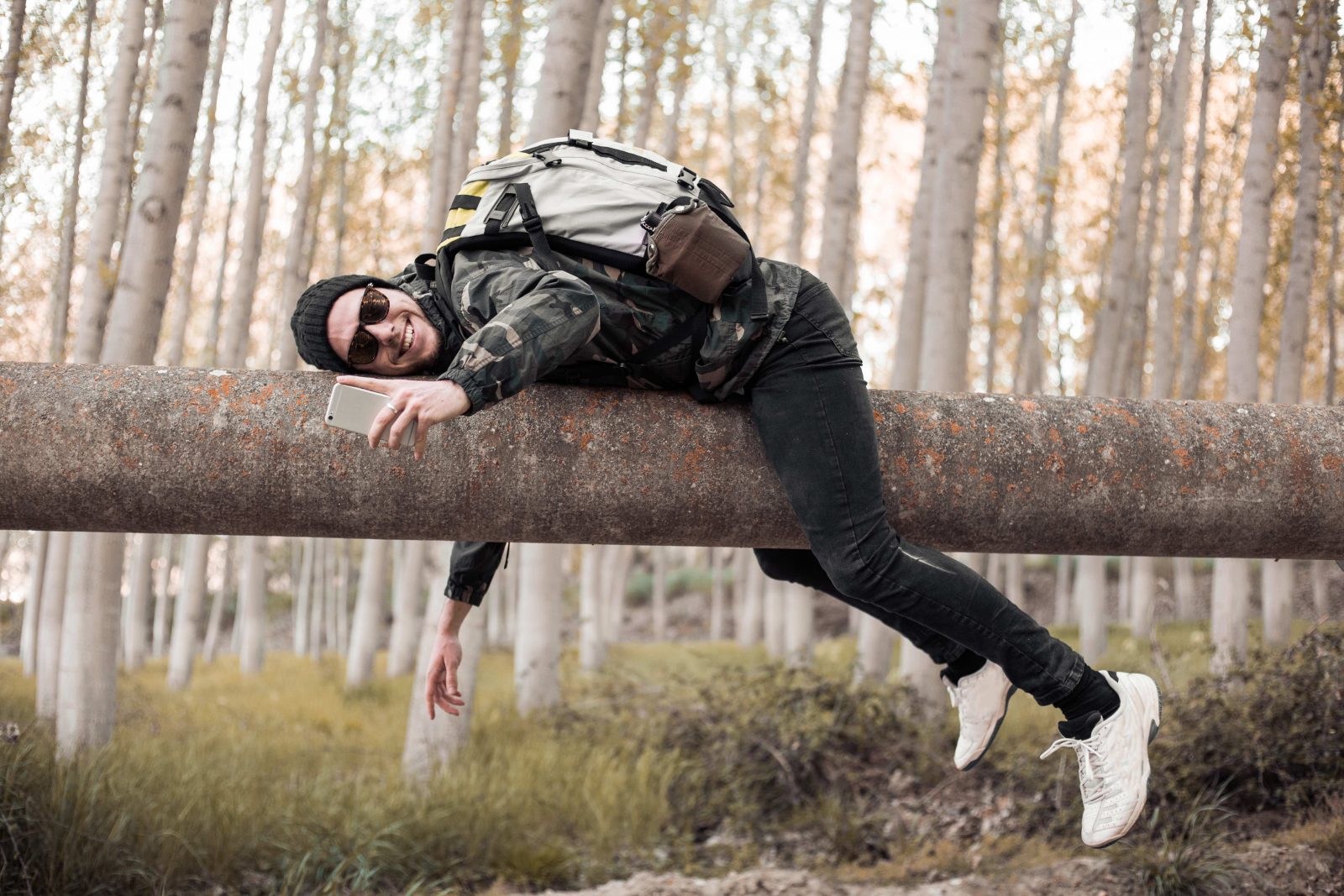
What inspired you to launch the site?
Three things. Firstly, a love of travel myself. Secondly, I felt that there was an opportunity to look at a different model in the travel industry that also fitted in well with a growing desire for people to travel “self guided”. Thirdly, I strongly believe that life is for living and am passionate about living a life that I enjoy.

I read a quote by American journalist Ellen Goodman some time a go and it always stuck with me: “Normal is getting dressed in clothes that you buy for work, driving through traffic in a car that you are still paying for, in order to get to a job that you need so you can pay for the clothes, car and the house that you leave empty all day in order to afford to live in it.” I find this scary and wanted to do something about it.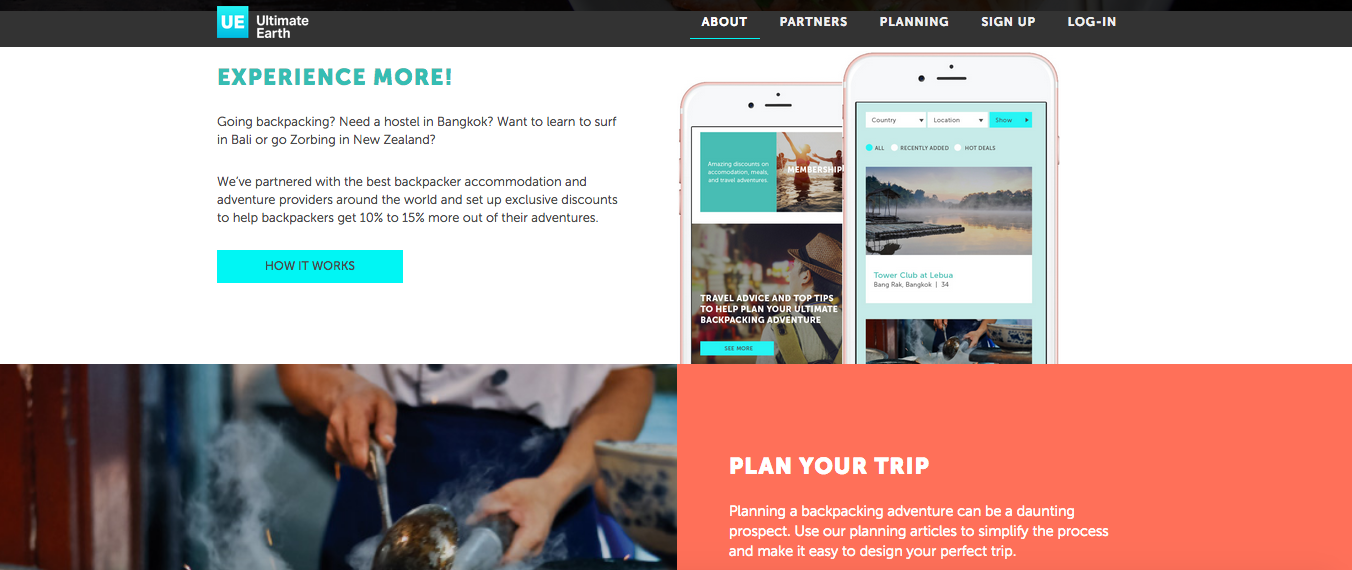
How would you describe your business model?
Win. Win. Win. Ultimate Earth sits in the middle, helping backpackers save money and partners (such as Road Trippers Vietnam, Billy Tea Safaris, Sydney Pub Tours and Rotorua Rafting) make money.
Because we only partner with a limited number of “ultimate” partners in backpacker hubs, we can help them stand out against the competition and experience higher utilisation rates.
How will Ultimate Earth save backpackers money?
Backpackers can sign up with Ultimate Earth and use their credentials to make direct bookings at discounted rates within our partner network. Each backpacker who signs up with Ultimate Earth gets a unique UE ID number, which our partners can validate to prevent misuse of the scheme.
Each partner has a slightly different approach when it comes to accepting direct bookings – all of which are documented in the individual partner profiles along with other useful information, a map and images, which backpackers gain access to when logged into the Ultimate Earth website or app.
How much does membership cost?
At the time of writing (September 2017) we are giving access to the scheme away completely free of charge. More members at this stage will help us attract more partners – in turn helping backpackers save even more money over the course of their trips.
When we do switch on payments, the amount will be dwarfed by the potential savings. I expect the cost in the medium term to be somewhere between £40 and £50 for six months’ access, with our objective being to save backpackers upwards of £200 a month on average.
How does the partners section of the site work?
Simply sign up and gain access to the profiles in the partners section of the website. We allow any website visitor to see which partners we are working with, as this is part of the decision-making process, but as soon as you try and access a profile, a message will pop up to say you need to be logged in to view the content.
Each partner profile contains information about how to make an advanced booking, whether or not the particular partner will accept walk-in bookings, along with information about the discount level, a description of the service(s) the particular partner provides and, finally, some images and a map.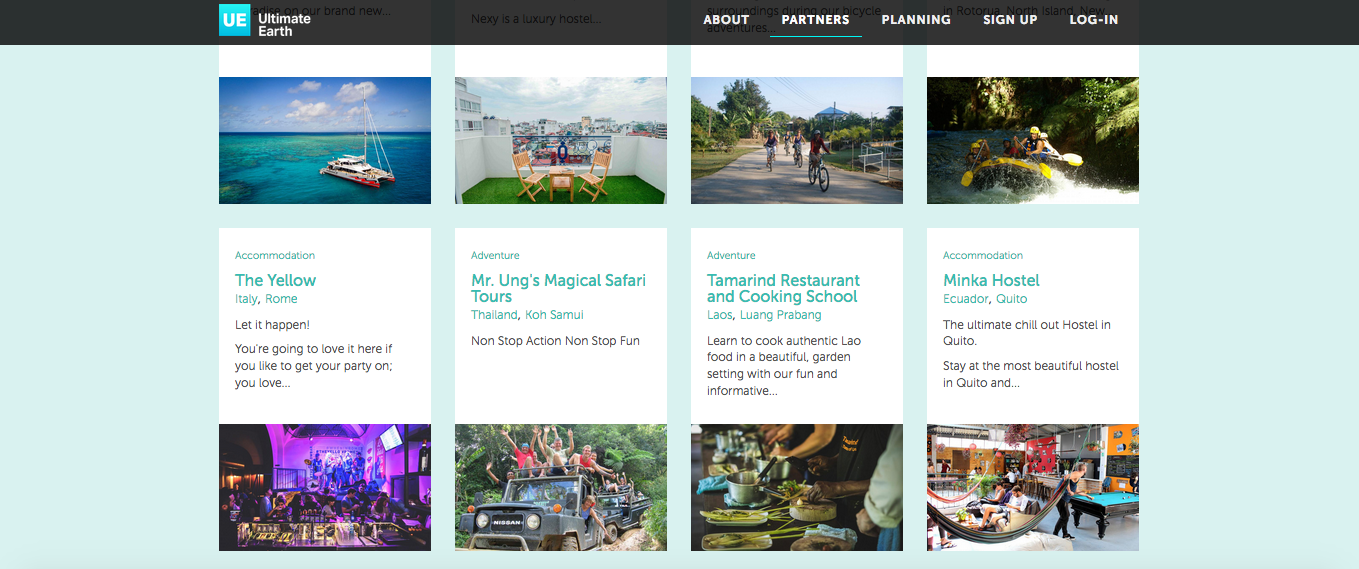
Why did you decide to integrate editorial within a planning section?
We have set out to help backpackers travel better and experience more. Beyond helping them save money, we hope to develop a useful planning resource to help backpackers better execute their adventures. There is a lot of very useful content out there, but sometimes you have to hunt around a bit and it’s not uncommon to read a whole blog post just to discover one useful bit of information.
In a world of digital marketing, it also sometimes feels like there is a lot of content for content’s sake. As we develop, we hope to create a first-port-of-call planning resource for Ultimate Earth backpackers, which can really fast-track them to the good stuff.
We will happily link out to other websites/blogs where appropriate, as we are not attempting to be the next big travel content site; we simply want to push Ultimate Earth backpackers in the right direction. We will also be encouraging community content where backpackers can help each other by contributing a bucket-list guide with key information.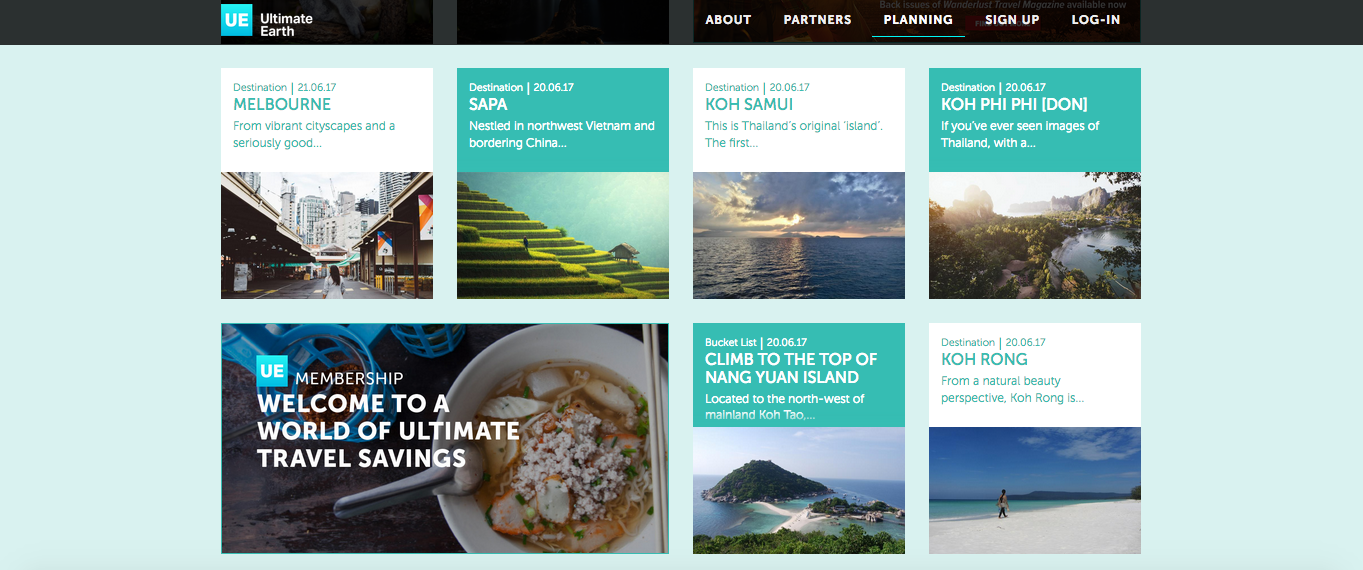
Are you a traveller yourself?
Absolutely. I was lucky to travel a lot with my parents when I was growing up, but my passion for travel was really ignited on a one-month college expedition to India, which remains my favourite country. I’ve got some great stories to share from around the world – from mountain biking down from the second-highest motorable pass in the world (Khardung La) in the Ladakh region of the Indian state of Jammu and Kashmir, to watching the sun come up over Angkor Wat (Cambodia), hot-air ballooning over Vang Vieng (Laos) and climbing Mt Kilimanjaro (Tanzania).
The story I think I’ll share, however, is when me and a friend went to Ecuador for a month of exploring. We spent the month trekking in the jungle, climbing mountains and having fun canoeing and tubing in the Amazon river basin. It’s memorable because our bags didn’t manage to make the connection in Caracas (Venezuela), so all we had with us for a month were the clothes we stood up in.
I only had a pair of shorts, a T-shirt, a light jumper and a pair of Toms canvas shoes – the most versatile shoe in the world it would seem. They didn’t half smell bad at the end, though. We were able to source a few bits from the markets/local towns but there were a few sizing issues to say the least – especially for my friend at 6ft 5. It could have completely rail-roaded the trip had I been with anyone else, but we had such a laugh and, if anything, it made the trip ten times better.
What’s on your hotlist of places to visit?
I tend to prioritise experiences over destinations, but if pushed for the places next up in my plans, I would say the Philippines, Japan and touring around Italy on the train.
